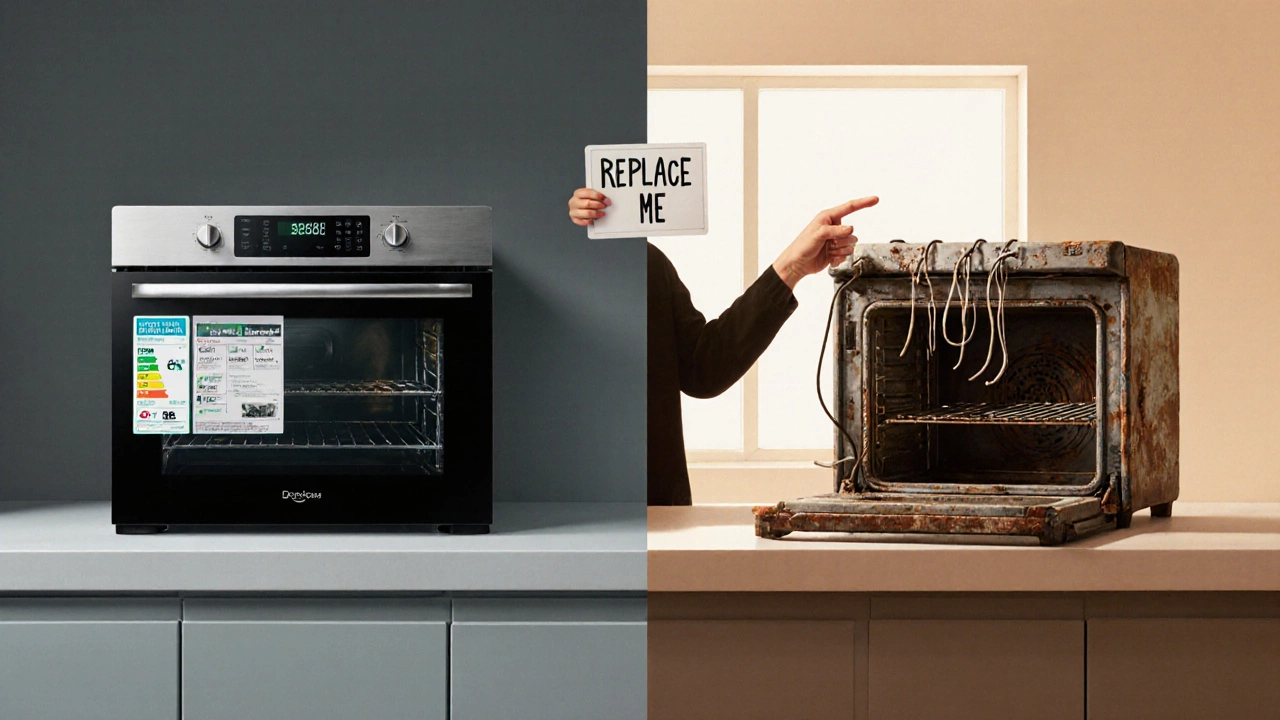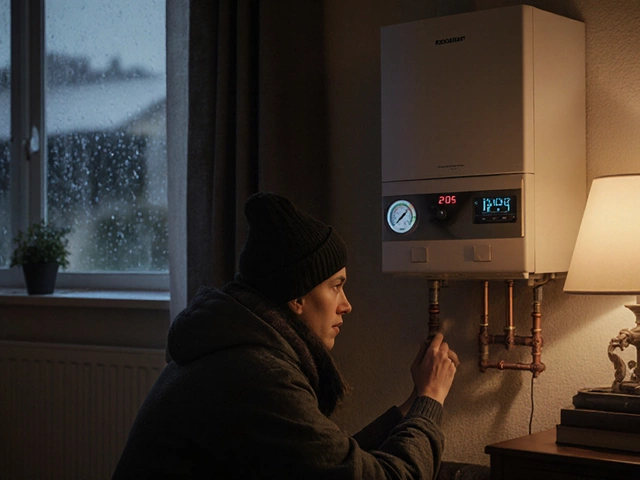If your electric oven won’t heat up, the display is blank, or it’s tripping the circuit breaker, you might wonder: should I call an electrician? The short answer is yes-but only if the problem is electrical. Most electric oven issues aren’t about wiring or power supply. They’re about broken heating elements, faulty thermostats, or failed control boards. And those? Those are the job of an appliance repair technician, not an electrician.
Why Most Electric Oven Problems Aren’t Electrical
Electric ovens run on 240 volts, which is the same as a dryer or air conditioner. That means they’re wired directly into your home’s electrical system. But here’s the thing: if the oven isn’t heating, it’s rarely because the circuit breaker is faulty or the outlet is dead. The problem is almost always inside the oven itself.Let’s say your oven turns on but doesn’t get hot. That’s a classic sign of a failed heating element. These are the coiled wires at the top and bottom of the oven cavity. They wear out over time. You can see if they’re broken or glowing unevenly when the oven is on. Replacing one costs under $50 and takes 20 minutes. An electrician won’t carry those parts. An appliance tech will.
Or maybe the oven displays an error code like F3 or E1. That’s the control board talking. It’s telling you the temperature sensor is reading wrong, or the relay has failed. These are electronic components inside the control panel. Fixing them requires knowing how to test continuity, measure resistance, and replace surface-mount boards. Again, that’s appliance repair territory.
When You Actually Need an Electrician
There are real cases where you need an electrician. But they’re rare. Here’s when:- Your oven won’t turn on at all, and the circuit breaker trips every time you try. That could mean a short in the wiring, a faulty isolator switch, or an overloaded circuit.
- You’re installing a brand-new oven and the existing 240V outlet doesn’t match the plug. Electricians handle rewiring and installing dedicated circuits.
- The oven’s power cord is frayed, melted, or the terminal block inside the back panel is burnt. That’s a fire risk. An electrician can safely replace the wiring and verify the circuit is grounded properly.
- You live in an older home with knob-and-tube wiring or aluminum branch circuits. These aren’t safe for modern high-draw appliances. An electrician should assess your whole kitchen circuit before you plug in anything new.
In Auckland, homes built before 1980 often have outdated electrical systems. If you’re replacing an oven and the old one worked fine but the new one keeps tripping the breaker, don’t assume the oven is faulty. Call an electrician first.
What Happens When You Call the Wrong Person
I’ve seen this too many times. Someone calls an electrician because their oven stopped working. The electrician shows up, checks the voltage at the outlet, confirms it’s 240V, and says, “Everything’s fine.” Then they charge you $150 and leave. The oven still doesn’t work.Why? Because they didn’t open the oven. They didn’t test the heating element. They didn’t check the thermostat or the control board. Electricians aren’t trained to diagnose appliance internals. Their tools are multimeters and clamp meters-not screwdrivers and thermal probes.
On the flip side, an appliance technician who doesn’t know how to check a circuit might miss a dangerous wiring fault. That’s why the best approach is to start with an appliance repair specialist. If they say, “The oven’s fine, but your circuit is overloaded,” then you call the electrician.

How to Tell the Difference: Appliance Tech vs Electrician
Here’s a simple way to decide who to call:
| Problem | Call Appliance Technician | Call Electrician |
|---|---|---|
| Oven doesn’t heat up | ✓ | |
| Display is blank or shows error codes | ✓ | |
| Breaker trips when oven turns on | ✓ | |
| Oven won’t turn on at all | ✓ (first) | ✓ (if wiring is suspect) |
| Smell of burning plastic or wires | ✓ | ✓ (call immediately) |
| Installing a new oven | ✓ (for circuit setup) |
Most appliance repair companies in Auckland offer free diagnostic calls. They’ll come out, check the oven, and tell you if it’s a part failure or a wiring issue. If it’s the latter, they’ll often recommend an electrician they trust. That’s the smart way to do it.
What Parts Are Most Likely to Fail?
If you’re trying to figure out what’s wrong before calling anyone, here are the top three culprits in electric ovens:
- Heating elements - These fail after 8-12 years. The top element (broil) goes first. You can test it with a multimeter. If it reads infinite resistance, it’s dead.
- Thermostat or temperature sensor - If the oven overheats or doesn’t reach the right temperature, this is likely the issue. The sensor is a thin probe inside the oven cavity. It costs $30-$60 to replace.
- Control board - This is the brain. If the oven turns on but doesn’t respond to button presses, or shows random error codes, the board may be fried. Replacement costs $150-$300, depending on the model.
Brands like Smeg, Bosch, and Samsung use similar parts. If your oven is less than 10 years old, most of these parts are still available. If it’s older, you might need to consider a replacement.
DIY or Professional? When to Try Fixing It Yourself
If you’re handy and your oven is under warranty, don’t open it up. But if it’s out of warranty and you’re comfortable with basic tools, you can replace the heating element yourself. You’ll need a screwdriver, a multimeter, and maybe a socket wrench. Unplug the oven first. Always.
YouTube has dozens of videos for specific models. Search “replace heating element [your oven model].” Most take under 30 minutes. You’ll save $100-$200 in labor.
But don’t try to replace the control board unless you’ve done it before. These boards are sensitive to static electricity. A single wrong touch can kill it. And if you install it wrong, you could fry the whole oven.

What to Look for in a Repair Service
If you’re hiring someone, here’s what matters:
- They carry parts for your brand. Ask: “Do you have a thermostat for a Bosch HBA53BRS0?” If they say “probably,” walk away.
- They test before replacing. A good tech won’t just swap parts. They’ll measure voltage, resistance, and continuity to confirm the fault.
- They offer a warranty on parts and labor. At least 90 days. If they don’t, they’re not confident.
- They’re licensed for appliance repair. In New Zealand, there’s no formal license, but look for membership with Appliance Repair Association of New Zealand or similar.
Don’t hire someone who shows up in a van with no logo or website. You’re dealing with a high-voltage appliance. You want someone professional.
When to Just Replace the Oven
If your oven is over 12 years old and needs a control board or multiple parts, replacement is usually cheaper than repair. A new mid-range electric oven costs $800-$1,500. Labor to replace it? $150-$250. You’re looking at $1,000-$1,750 total.
Compare that to repairing a 15-year-old oven with a $250 control board, $50 heating element, and $120 labor. That’s $420. Sounds good-until you realize the next thing to break is the door seal or fan motor. And the energy bill? Older ovens use 30-40% more power than new ones.
If your oven is older than 10 years, and the repair cost is more than half the price of a new one, think hard. New ovens come with better safety features, smarter controls, and lower running costs.
Final Advice: Start with an Appliance Tech
Don’t assume your oven problem is electrical just because it’s an electric oven. Most of the time, it’s not. Start with a qualified appliance repair technician. They’ll diagnose it quickly, tell you if it’s fixable, and if it’s not, they’ll tell you whether you need an electrician-or a new oven.
And if you’re ever unsure? Call both. A good appliance tech won’t mind. They’ll say, “Let me check the oven first. If it’s wiring, I’ll point you to someone who can fix it.” That’s the kind of service you want.





